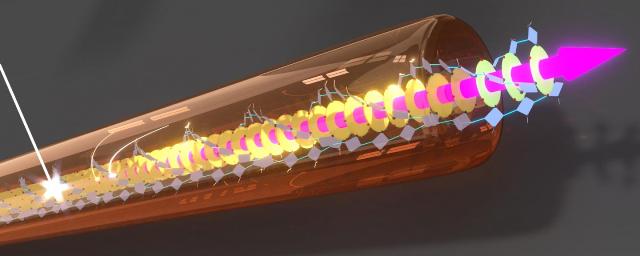For the first time, a team of scientists from the Universities of Erlangen-Nuremberg (Germany) and Bayreuth has described how novel nanostructures can be used to transport energy across several micrometers at room temperature.
 This is a supramolecular nanofiber consisting of more than 10,000 perfectly ordered building blocks, which enables an energy transport over a distance of more than 4 micrometers at room temperature. Credit: Picture by A. T. Haedler.
This is a supramolecular nanofiber consisting of more than 10,000 perfectly ordered building blocks, which enables an energy transport over a distance of more than 4 micrometers at room temperature. Credit: Picture by A. T. Haedler.
The distance of transport can be elucidated only with quantum coherence effects along separate nanofibers.
With growing energy consumption in the world, a low-cost method for converting sunlight into electricity holds major significance. In order to meet this need, innovative device concepts have to be developed, where energy produced by light is transported without any significant loss.
At the University of Bayreuth, the research groups of Hans-Werner Schmidt (Macromolecular Chemistry) and Richard Hildner (Experimental Physics) formulated supramolecular nanofibers that can include over 10,000 similar building blocks.
Carbonyl-bridged triarylamine form the heart of the building block. This derivative of triarylamine was initially produced by the research team of Milan Kivala (Organic Chemistry) at the University of Erlangen-Nuremberg, and then later chemically altered at the University of Bayreuth. Connected to this middle unit are three naphthalimidbithiophene chromophores.
Under particular conditions, the building blocks self-organize quickly and produce nanofibers that measure over 4 µm in length and just 0.005 µm in diameter. To draw a comparison, the thickness of a human hair measures around 50 to 100 µm.
Using different microscopy methods, the University of Bayreuth researchers were able to observe the excitation energy transport along the nanofibers. In order to acquire this long-range transport of energy, the triarylamine cores present in a precise face-to-face configuration work in concert. This makes it possible to transfer the energy in a wave-like fashion from one building block to the subsequent building block. Such a phenomenon is known as quantum coherence.
"These highly promising nanostructures demonstrate that carefully tailoring materials for the efficient transport of light energy is an emerging research area" said Dr. Richard Hildner, a specialist in the field of light harvesting at the University of Bayreuth.
The light harvesting research field aims for an accurate description of energy transport processes which occur in natural photosynthetic machineries. This knowledge can be leveraged to develop innovative nanostructures that can harvest power from sunlight.
In this field, an interdisciplinary consortium of scientists has collaborated together in the Bavarian initiative Solar Technologies Go Hybrid, as well as in the Research Training Group Photophysics of synthetic and biological multichromophoric systems (GRK 1640), supported by the German Research Foundation (DFG).
The study was published in Nature on nanofibers.